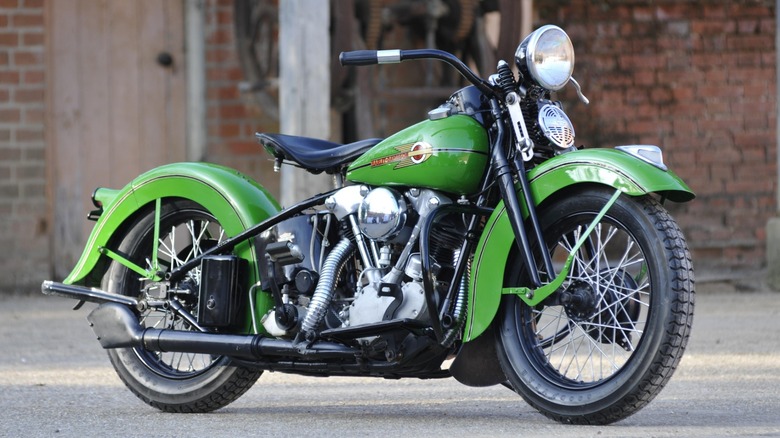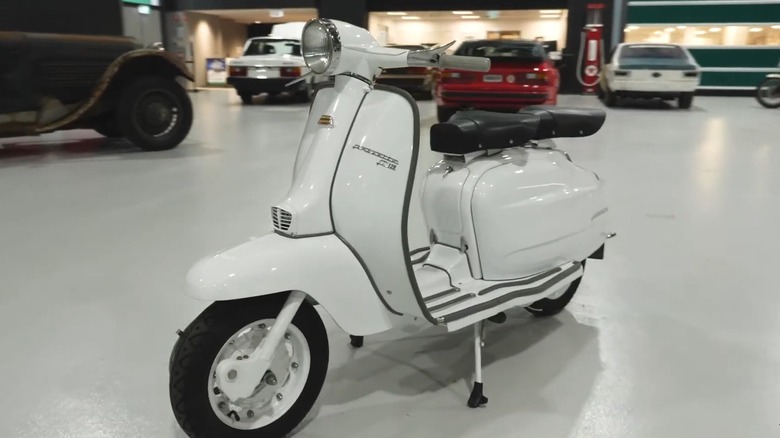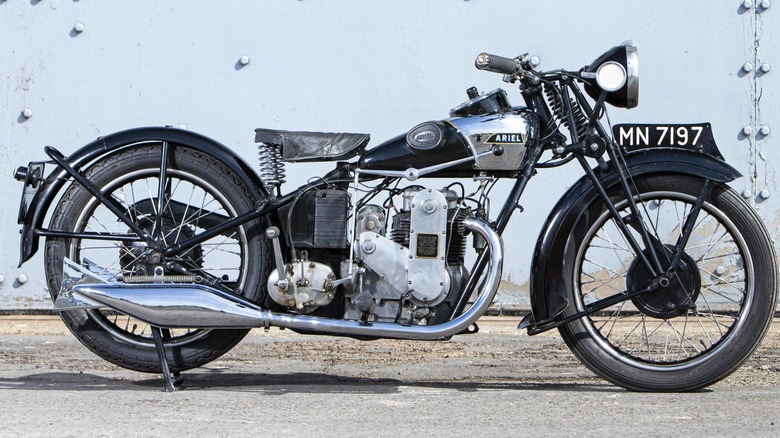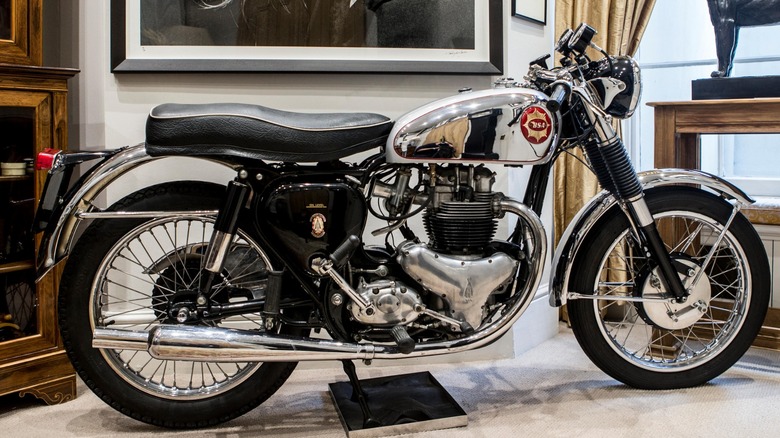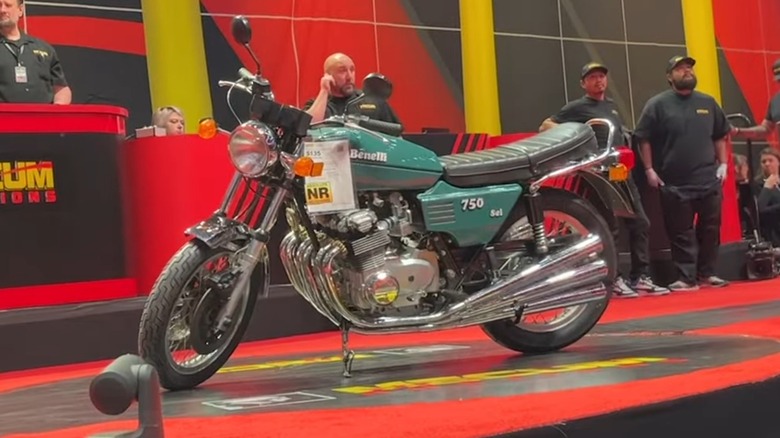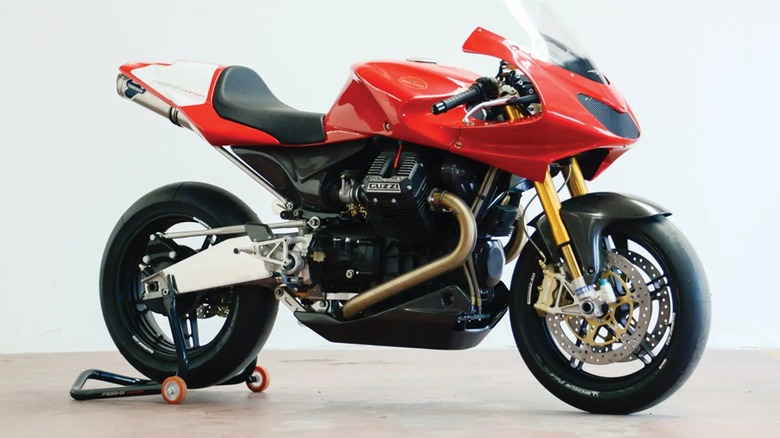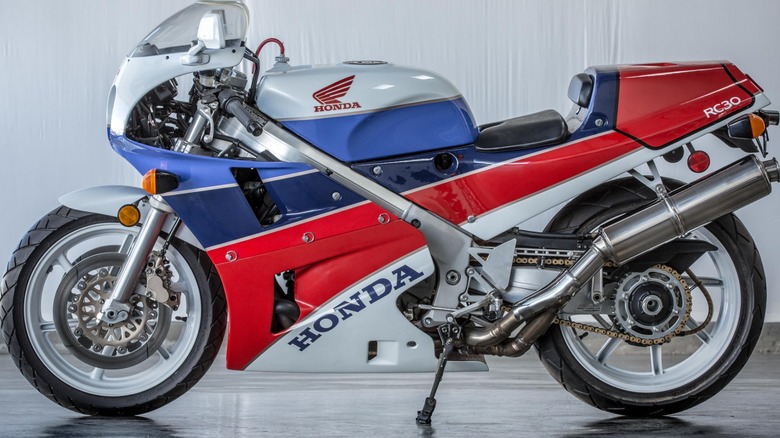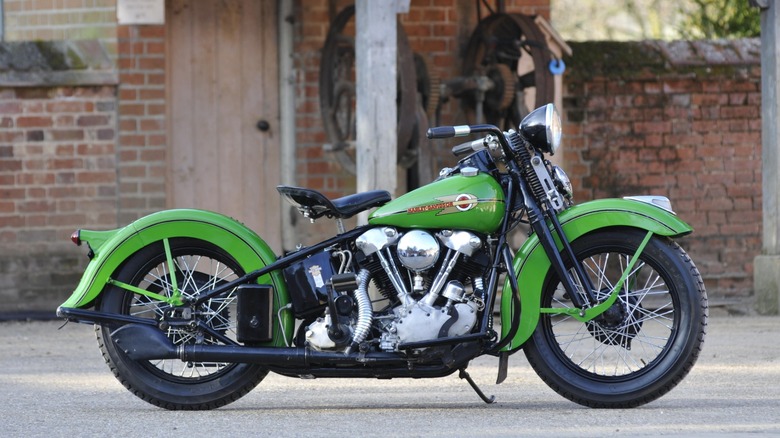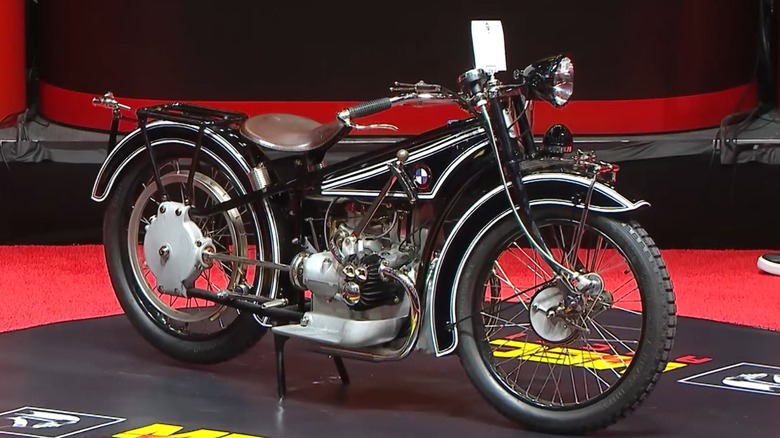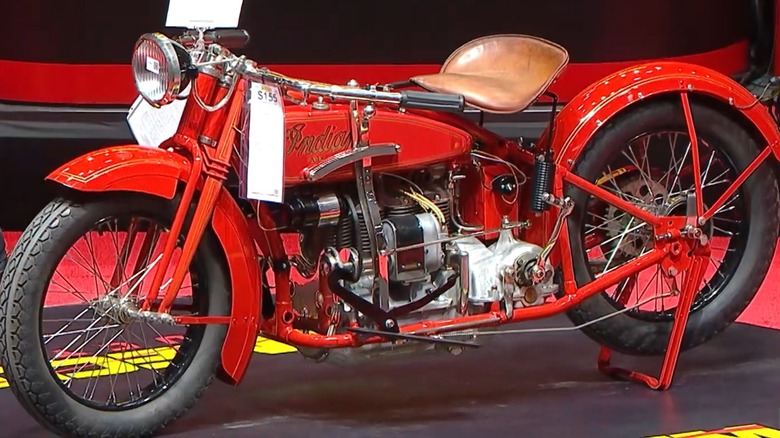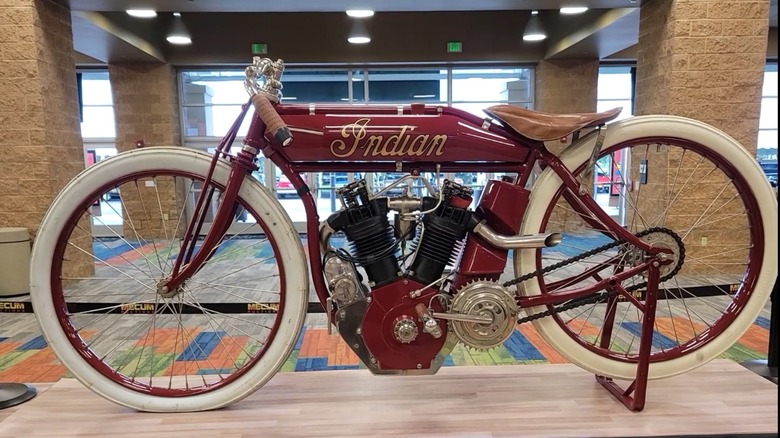10 Of The Most Beautiful Motorcycles Ever Sold At Auction, Ranked By Price
To some, motorcycles are nothing but a noisy engine strapped to a metal frame with a couple of wheels. They're nothing special, and they're dangerous. But to motorcycle riders, these opinions don't count. To them, the two-wheeled machines built in the last 120 or so years are works of mechanical art and a perfect amalgamation of beauty in motion.
Of course, motorcycles are transportation at their core. Many, if not most, are produced for the purpose of getting people to the places they need to go. In some areas of Asia and Africa, two-wheelers dominate, and how they look is very far down on the priorities list. To those who don't rely on a bike for basic transportation, manufacturers have for years gone the extra mile to make sure bikes have practicality and style.
A robust market for vintage and antique motorcycles keeps historical rides in premium condition for some to admire and a very lucky few to ride and enjoy. Regardless, there are an awful lot of engaging machines both in aesthetics and operation, new and old. As always, beauty is in the eye of the beholder, but here are the most beautiful regular production bikes to have run across the auction block, starting with the most affordable, bearing in mind that cost and beauty are not inextricably linked — but often go hand-in-hand.
1964 Lambretta Li125 - $8,000
Most people, enthusiasts or not, have some level of familiarity with Vespa, the popular and iconic Italian manufacturer of motor scooters. However, Italy once gave us another attractive scooter known as Lambretta. If not for changing market dynamics, the ailing health of the founder, and a failure to modernize, Lambretta could be just as iconic today.
Lambretta production commenced in 1947 and ended in 1971, which means a 1964 Lambretta Li125cc was built when the company was in its prime and at the cutting edge of technology and design, the latter of which was of the highest caliber. This bike received a 123cc 2-stroke single integrated with a 4-speed transmission while serving as the rear swingarm. Horsepower was only rated at 5.2 and the brakes front and rear were ineffective drums, but those details are less important than how good you look while riding it.
All the mechanical bits are hidden by sculpted sheet metal while riders sit on individual saddles with a broad leg shield to keep muck from the city streets from soiling your fashionable Italian pants. Today, a Lambretta represents a comparatively affordable classic. In 2021, Shannon's Insurance in Australia put up a beautiful gleaming white example in immaculate condition, selling it for AU $12,500. At current exchange rates, That's about US $8,000, but what you receive in class and style is a bit harder to quantify, and for cruising narrow medieval streets, there are few choices better than this.
1931 Ariel 497cc Model 4F 'Square Four' - $29,000
Ariel's origins come from the Victorian Era when its first product was built, an 1871 Ariel Ordinary. It produced a variety of motorized vehicles over the years, including a few cars, but its motorcycles are a highlight for the company. Ariel motorcycle production continued through 1971, covering some of the best years of the British motorcycle industry.
One of Ariel's most novel creations was the Square Four engine, featuring two sets of cylinders with dual crankshafts and overhead cams laid out in a square pattern. While it seems overly complicated, the result is an incredibly smooth engine, and after it was updated in 1936, it became incredibly reliable. The unique square layout made it compact — the first 500cc iteration fit into a bike made for a 250.
Ariel was certainly an outlier in terms of engine design, but it continued using its unique engine until production ended in 1971. Some of its early Square Four models are also some of the most captivating. Much of the mechanicals are exposed on a 1931 4F, and the finished components are sparse, although the fuel tank's partial chrome plating is a nice touch. The tank-mounted gauges add sophistication and a touch of luxury thanks to the addition of a clock, a rare feature. Nicely kept or restored copies of early Square Fours fetch a handsome sum today. Bonham's sold a 1931 model in 2021 on a no reserve auction for about $29,000.
1964 BSA 646cc Rocket Gold Star - $25,015
Like many other motorcycle brands, the company that made BSA models started in another industry. The Birmingham Small Arms company began in 1861 producing rifles in England, eventually being a significant supplier to the British military. BSA produced motorcycles from 1910 through 1973 with breaks during WWI and WWII when it concentrated on arms.
By the 1950s, BSA was a global powerhouse exporting British bikes all over the world, helping to establish the country as a leader in the market. After WWII, its parallel twin debuted, quickly becoming the engine of choice for BSA buyers. 500cc engine popular in the '50s gave way to an excellent 650 in the '60s. Unfortunately, BSA failed to properly respond to competition from Japan and was gone by 1973.
While still in its prime, BSA built the 1962 to 1963 Rocket Gold Star, a highly desirable model from BSA created as a factory-built cafe racer. The turned down handlebars and powerful engine make a great combination for setting to the track, which many owners then did. Furthermore, the abundance of chrome makes it a perfectly beautiful and shiny example of the best of the British bikes of its time. With limited production, they are valuable today — the last one ever built sold At Bonham's for £19,550, aboit $25,000, in 2022.
1978 Benelli Sei - $40,000
All modern Benelli motorcycles are produced in the same place as its parent company, China. And while Qianjiang Motor Group is the current owner of the Benelli, it has deep Italian roots in the motorcycle industry, dating back to 1911. Throughout the 20th century, Benelli was a smaller player in the Italian motorcycle industry but that never stopped it from producing exciting bikes and keeping up on the racing circuits.
Today, Benelli's bread and butter is machines on the smaller side, such as its small but fun and agile Benelli TNT 135. That was not always the case, especially considering it built and sold the world's first 6-cylinder production motorcycle, the Benelli Sei, Italian for six. You may be aware of the Kawasaki Z1300 or the Honda CBX 1000 6-cylinder bikes, but Benelli was first in 1972, created as one of the first models under the ownership of Alejandro De Tomaso.
As a smaller player in Italian motorcycles, Benelli production numbers were limited. With a model so unique and boundary pushing as the Sei, well-kept models today can be pricey. While these bikes are more sedate than a flashy American v-twin, they have the enduring classic 1970's sport bike look, and they are beautiful machines, especially considering the stunning triple horn exhaust on each side. Mecum set a record for this model in 2024 when the hammer came down on one particularly nice example for $40,000 in Las Vegas.
2008 Moto Guzzi MGS-01 Corsa - $50,900
Whether you are talking about blazers, automobiles, or motorcycles, nobody will argue that Italians have style. Moto Guzzi, founded in Genoa in 1921 has a history of making stylish motorcycles as well as winning on the track. Furthermore, it developed excellent machines over the years, but it was in 1967 that the defining feature of the brand debuted, the Moto Guzzi transverse v-twin. Unlike American v-twins, mounted parallel to the frame, Moto Guzzi's cylinders sit perpendicular to the frame, protruding from each side and creating the unmistakable Moto Guzzi look.
Piaggio bought an ailing Moto Guzzi in 2004, injecting much needed capital for new models, but the company had already developed the fabulous 2008 Moto Guzzi MGS-01 Corsa — fortunately, Piaggio ensured its production. This absolute demon of a machine features an engine based on that of one of the best Moto Guzzi bikes ever made, the Daytona 1000. The eight-valve v-twin is built with pistons courtesy of Cosworth and Marelli fuel injection, which combine to give it 122 horsepower, an excellent performance figure from an air-cooled twin.
The MGS-01 was produced in limited numbers of 130 to 150 total units and initially sold for $24,990. It is a striking motorbike having the look of going fast while standing still, and the big protruding air-cooled cylinders elevate its machismo. Buyers when it was new were rewarded with good appreciation as one sold by Sotheby's in 2016 ended with a bid of €39,780.
1988 Honda VFR750R Type RC30 - $50,900
While Honda made its mark in America proclaiming "You meet the nicest people on a Honda" and selling small, efficient, and reliable motorcycles, by the late '80s, it was selling ever-increasingly sophisticated machines with generous power output and superb handling. This was backed up by a successful racing program, the technology that came from it.
This particular model was created by Honda Racing Corporation (HRC). While many racing series see manufacturers pick a production street bike and modify it according to the rules, HRC created a bike for the race with the intention of selling a version to the public in limited numbers. The result was the Honda VFR750 R, also known as the Type RC30. It used Honda's venerable V4 engine with materials unheard of for a street bike at the time including titanium rods, carbon fiber, kevlar, magnesium, gear-driven cams, and more.
Built at a time before screens and traction control, the RC30 is wonderfully analog, with large and prominent gauges sitting uncluttered behind the fairing. It sports 18-inch wheels in white accompanied by HRC racing colors. It is bold, loud, and undeniably '80s. Yet it is beautiful in an old and brutish way that is rather endearing. Today the values are costly without being astronomical. While one sold by Bonham's in 2018 for $92,000, other auctions ended with more reasonable bids, such as $52,900 in 2015 and $29,900 (about $50,900) in 2021.
1938 Harley-Davidson EL - $190,000
1936 was a prominent year in Harley-Davidson history as it is the year of the first overhead-valve Harley v-twin. Problems with previous engines began to tarnish Harley's image, and this engine sought to iron it out with better technology. Along with the new valve placement, the new engine also received a dry sump oiling system to replace the messy total loss system from before. Buyers took to the new engines right away, affectionately calling them "Knucklehead" for the shape of its rocker covers. The name stuck.
Hallmarks of Depression-era Harleys continue to influence its design today. Large bikes with big fat tires sitting under deep fenders with wide saddles and even wider handlebars quickly identify Harleys from this time while the big v-twin engines and teardrop gas tanks of these models continue to identify them.
Most of the bikes from the era were highly stylized and ornate, with beautiful color schemes and iconic art deco branding on the tank. Some bikes came with stylish two-tone paint with pinstripes while others came in bright and bold blue and red while a shiny gloss black has always been in style. Today, a Harley-Davidson EL is a valuable motorcycle. Production levels were much lower back then, leaving a small pool of desirable bikes today. As such, auctions can get heated – Mecum sold an exquisite 1936 model in 2022 for $190,000.
1925 BMW R37 - $220,000
Many motorcycles from the 1920s fail to elicit much emotion based purely on aesthetics. This was a time when the industry was still in its nascent stage and motorcycles were not too far removed from being barely more than a bicycle with an engine bolted on. However, one company that managed to infuse beauty into its mechanicals early on was BMW Motorrad.
The first BMW motorcycle debuted in 1923. The R32 quickly established BMW as an innovator, displaying several unique features of which some endure to this day. Most prominently, it came with a horizontally opposed boxer engine, a feature that has defined BMW motorcycles ever since. Integrated with the gearbox, this new engine layout made for a highly compact package, allowing for the other unique feature, a fuel tank installed below the upper frame rail.
With a couple of years to manufacture regular production models under its belt, BMW took its R32 and modified it for racing. The race-ready model was named the R37, and while it still had the same boxer engine, this one put out double the horsepower, allowing riders to win the German championship from 1925 to 1929. These early BMWs managed to establish the company as a premium motorcycle manufacturer and today they are quite rare. For the good fortune of owning one, you might have to lay out as much as $220,000 as one buyer did as a Mecum auction in 2019.
1927 Indian Ace - $220,000
While the current Indian FTR X 100% R Carbon is a fantastic bike that comes with all the modern amenities one would expect, the company has a long and storied history with some excellent machines built along the way. Since domestic production ended in 1953 and was not meaningfully restarted again until 2011, most of those models are from the pre-war era. Regardless, Indians from this era are both interesting and quite beautiful.
In 1927, Indian bought the ACE motorcycle corporation, taking over all of its assets, including manufacturing parts and designs. Indian then took the 1,265cc F-head engine it acquired from Ace and installed it in a Scout frame. Initially, it was called the Indian Ace but later renamed the Indian Four and kept in production until 1942.
The Ace is a beautiful bike with all of the best design elements of its era. A deep front fender with a wide saddle accentuates the low-slung 4-cylinder that rests below a wide fuel tank sitting within the exposed frame. Fat tires on wire wheels continue the Depression-era styling, but the Indian head mascot on the front fender completes the look. Rarity of these bikes has also driven up prices to extreme levels. Mecum sent one of the 260 models built across its stage in 2023, attracting a winning bid of $220,000.
1915 Indian 8-Valve Board Track Racer - $285,000
Many racing fans in the 1910s were treated to a phenomenal spectacle known as board track racing. It was a highly competitive sport pitting man and machine against each other around a circle track constructed of wood planks, and the one thing they all hoped for was not to die. It was an extremely dangerous sport and there is good reason why it didn't last into the '20s.
While the sport did not last, some of the motorcycles used in it did. Most of them are long gone, although some remain. They were also outfitted with the best technology possible for the day. For Indian, this meant stuffing a 1000cc v-twin engine in one of its frames and changing the head to a four-valve setup. This allowed Indian to take advantage of the better flow of overhead valves but avoided overheating using multiple smaller valves.
The Indian board track racer of 1915 managed to reach a speed of 132 mph in 1922, an incredible feat given the technology of the era. That record went unchallenged until the 1930s. Only four of these early racing Indians are known to still exist today, making them among the rarest of special antique motorcycles. When Mecum put one in its Monterey auction in 2023, it sold for an astonishing $285,000, putting it into the highest echelon of vintage motorcycles sold.
